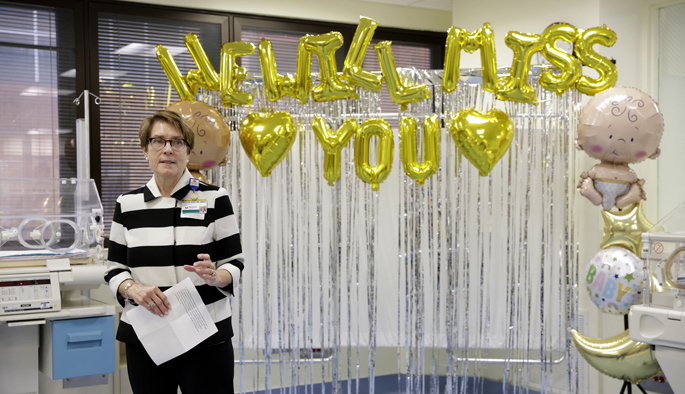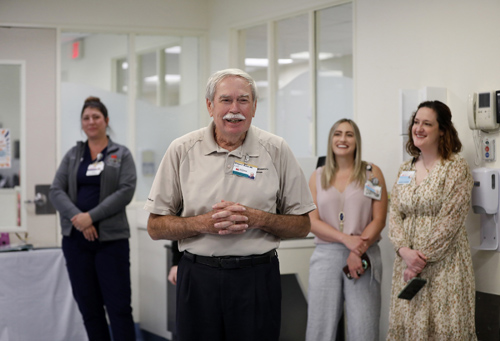
The Stahlman Neonatal Intensive Care Unit (NICU), one of the first modern neonatal intensive care units in the world, cared for its last baby and closed at the end of May. Located in Vanderbilt University Hospital, and named for neonatal intensive care pioneer Mildred Stahlman, MD, it opened in 1980 and operated adjacent to Labor and Delivery with 16 licensed beds and overflow capacity.
The name and mission of the Stahlman NICU live on in the new Stahlman Suite, a four-bed, 850-square foot resuscitation unit just steps from the original Stahlman NICU. In this space, babies in need will be stabilized before moving to the NICU at Monroe Carell Jr. Children’s Hospital at Vanderbilt or to the Special Care or Transition Care nurseries. The Monroe Carell NICU, which has seen significant growth over the years, now has 116 beds spanning across two floors of the hospital with continued planned growth on the hospital’s pending expansion floors.
On the final day of the Stahlman NICU, a reception was held to celebrate and honor the staff and families whose lives were profoundly changed by the unit over the past 43 years. Faculty and staff, past and present, returned to say goodbye to the space and share stories.
“This unit was state of the art when it opened in 1980, as it allowed for critical care medicine to be simultaneously delivered and developed,” said Meg Rush, MD, MMHC, President of Monroe Carell. Rush did her first rotation in the Stahlman NICU as a pediatrics resident in 1984.
“In the 1980s and through much of the early-to-mid 1990s, this unit also had adjacent research space (eventually reconfigured to allow the nursery to add beds). Clinical discovery has always been part of what we do in neonatology, and the unit served not only as a hub of intensive care for critically ill babies but also a hub of clinical research — as well as a space to teach residents and fellows. The field of neonatology was still pretty young when this unit opened,” Rush said.

In its first full year of operations, the Stahlman NICU saw 392 total admissions. In 2022, there were more than 1,500 between the Stahlman and Monroe Carell NICUs. In total, the NICU admits up to 25% of all deliveries at Vanderbilt, which totaled 5,100 last year. Labor and Delivery anticipates deliveries will grow by thousands more in the future.
“Our Department of Obstetrics has grown both in overall deliveries but also expertise in high-risk pregnancies, and those babies often need NICU care,” Rush said. “Our operations teams and departments of OB-GYN and Pediatrics have worked for several years to develop a plan to better serve our growing community with moms and babies together. The vacated Stahlman unit will be converted to labor and delivery rooms to accommodate this growth.”
In her speech, Rush paraphrased the late David Karzon, MD, who created the concept of a children’s hospital within a hospital and became the first medical director of Vanderbilt Children’s Hospital in 1970, saying, “The Stahlman unit was more than a place — it was a hub of advancing clinical care, discovery and training.”
Dupree Hatch, MD, associate professor of Pediatrics and medical director of the NICU at Monroe Carell, has worked in the Stahlman NICU since 2008: first as a resident, then a fellow and finally as an attending physician.
“The memories that are most vivid in my mind involve standing at the bedside of a sick infant in the middle of the night trying to understand their physiology or implement a plan to stabilize their condition,” he said. “I can remember the bed spots and the infants, but more than that I remember the people who were with me through those events — the nurses, respiratory therapists, trainees, nurse practitioners. Those relationships are what made Stahlman such a fun place to work.”
Marlee Crankshaw, DNP, RN, CNML, associate nursing officer in Neonatal Services at Monroe Carell, who did her first shift as a new graduate nurse in the Stahlman NICU on Halloween in 1983, has witnessed countless “medical miracles” throughout the years.
“There are so many memories of how nurses and providers worked together to care for critically ill babies,” Crankshaw said. “I was in awe of what I was able to learn and witness. So many of the babies had little chance of survival — and they were able to go home with their families.”
Though the room was filled with love and laughter, old photos and hugs at the reception, many of the staff are grieving the closing of the historic space.
“That’s understandable based on how impactful that unit has been over the past four decades,” Hatch said. “That unit was home to some of the early trials of therapies that have shaped modern neonatal care. Locally, it was also place where a whole generation of neonatologists, pediatricians, neonatal nurses and neonatal respiratory therapists (among multiple other roles) grew up and learned to practice neonatal medicine.
“The impact of that NICU on neonatal care can probably never be quantified. Just as it was when it opened in the early 80s, the closing of the Stahlman NICU represents a period of exciting growth in neonatal care at VUMC, and that growth will allow us to better care for the needs of critically ill infants in our region.”












